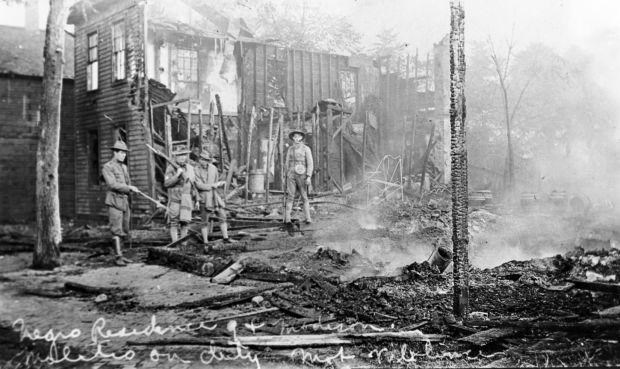Last updated: August 20, 2020
Article
Illinois: 1908 Springfield Race Riot Archaeological Site

SANGAMON VALLEY COLLECTION, LINCOLN LIBRARY
On August 14, 1908 newspapers published reports of a black man’s attempted assault of a white woman at her home the night before, and soon afterwards another assault of a white woman by a black man was reported and an inflamed mob sought out the assailants. However, when the mob was turned away from the jail and could not get to the alleged assailants they took out their ire on two other black men in the area, Scott Burton and William Donegan, neither of which had committed a crime, yet the two were quickly lynched.
Further, mob leaders instructed the mob to target the homes and businesses of Springfield’s black families, leaving white-owned properties untouched. Black residents attempted to fight in self-defense to protect their property and personhood only to be brutally attacked and in some cases killed, and over the course of the event and immediately after, nearly 2,000 black residents fled the city to never return. After nearly three days of constant violence, the state militia helped to restore order, and approximately 150 participants were arrested, although few were ever convicted of a crime.
The riot brought Illinois’s state capital to national infamy as newspaper outlets across the country condemned the violence, placing blame mostly on the city’s large European immigrant population, which further obscured the Midwest’s own localized history of antiblack violence.
The 1908 Springfield Race Riot occurred at a time of increasing racial unrest in the United States when lynching and other modes of antiblack violence were commonplace, not just in the Southern United States, but also across the country. The period between 1885-1910 was the most intense, and this type of violence was commonplace in the lower Midwestern states of Ohio, Indiana, and Illinois with more than three dozen documented incidents of white mob induced violence.
While the violence that took place that August quickly faded from public memory in Springfield, it became the impetus for the creation of the National Association for the Advancement of Colored People (NAACP) as W.E.B. DuBois and other reformers from the Niagara Movement saw the necessity for the creation of a progressive civil rights organization. On February 12, 1909, the centennial of President Abraham Lincoln’s birth, an interracial group of reformers from all walks of life established the NAACP.
The 1908 Springfield Race Riot site contains the foundations of five of the dozens of homes that were destroyed during the riot that engulfed the city over the course of those two days. The site (dentified as Badlands Site 1) became part of the African American Civil Rights Network in August 2020.
The African American Civil Rights Network recognizes the civil rights movement in the United States and the sacrifices made by those who fought against discrimination and segregation. Created by the African American Civil Rights Act of 2017, and coordinated by the National Park Service, the Network tells the stories of the people, places, and events of the U.S. civil rights movement through a collection of public and private elements.
